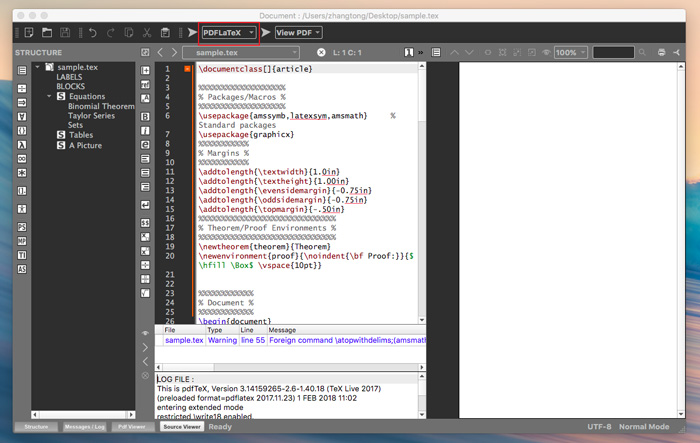Auto Compiling Script Tex File For Mac
Using Python on a Macintosh Author: Bob Savage Python on a Macintosh running Mac OS X is in principle very similar to Python on any other Unix platform, but there are a number of additional features such as the IDE and the Package Manager that are worth pointing out. The Mac-specific modules are documented in.
Python on Mac OS 9 or earlier can be quite different from Python on Unix or Windows, but is beyond the scope of this manual, as that platform is no longer supported, starting with Python 2.4. See for installers for the latest 2.3 release for Mac OS 9 and related documentation. Getting and Installing MacPython Mac OS X 10.8 comes with Python 2.7 pre-installed by Apple. If you wish, you are invited to install the most recent version of Python from the Python website. A current “universal binary” build of Python, which runs natively on the Mac’s new Intel and legacy PPC CPU’s, is available there. What you get after installing is a number of things:. A MacPython 2.7 folder in your Applications folder.
In here you find IDLE, the development environment that is a standard part of official Python distributions; PythonLauncher, which handles double-clicking Python scripts from the Finder; and the “Build Applet” tool, which allows you to package Python scripts as standalone applications on your system. New presonus notion 6 music notation software boxed version for mac pro. A framework /Library/Frameworks/Python.framework, which includes the Python executable and libraries. The installer adds this location to your shell path.
To uninstall MacPython, you can simply remove these three things. A symlink to the Python executable is placed in /usr/local/bin/.
The Apple-provided build of Python is installed in /System/Library/Frameworks/Python.framework and /usr/bin/python, respectively. You should never modify or delete these, as they are Apple-controlled and are used by Apple- or third-party software. Remember that if you choose to install a newer Python version from python.org, you will have two different but functional Python installations on your computer, so it will be important that your paths and usages are consistent with what you want to do.
IDLE includes a help menu that allows you to access Python documentation. If you are completely new to Python you should start reading the tutorial introduction in that document. If you are familiar with Python on other Unix platforms you should read the section on running Python scripts from the Unix shell. How to run a Python script Your best way to get started with Python on Mac OS X is through the IDLE integrated development environment, see section and use the Help menu when the IDE is running. If you want to run Python scripts from the Terminal window command line or from the Finder you first need an editor to create your script. Mac OS X comes with a number of standard Unix command line editors, vim and emacs among them.
If you want a more Mac-like editor, BBEdit or TextWrangler from Bare Bones Software (see ) are good choices, as is TextMate (see ). Other editors include Gvim and Aquamacs. To run your script from the Terminal window you must make sure that /usr/local/bin is in your shell search path. To run your script from the Finder you have two options:. Drag it to PythonLauncher. Select PythonLauncher as the default application to open your script (or any.py script) through the finder Info window and double-click it.
PythonLauncher has various preferences to control how your script is launched. Option-dragging allows you to change these for one invocation, or use its Preferences menu to change things globally. GUI Programming on the Mac There are several options for building GUI applications on the Mac with Python. PyObjC is a Python binding to Apple’s Objective-C/Cocoa framework, which is the foundation of most modern Mac development. Information on PyObjC is available from.
Auto Compiling Script Tex File For Mac Download

The standard Python GUI toolkit is, based on the cross-platform Tk toolkit. An Aqua-native version of Tk is bundled with OS X by Apple, and the latest version can be downloaded and installed from; it can also be built from source. WxPython is another popular cross-platform GUI toolkit that runs natively on Mac OS X. Packages and documentation are available from. PyQt is another popular cross-platform GUI toolkit that runs natively on Mac OS X. More information can be found at.

Note The resource editors do not directly read.rc or resource.h files. The resource compiler compiles them into.aps files, which are consumed by the resource editors. This file is a compile step and only stores symbolic data. As with a normal compile process, information that is not symbolic (for example, comments) is discarded during the compile process.
Whenever the.aps file gets out of synch with the.rc file, the.rc file is regenerated (for example, when you Save, the resource editor overwrites the.rc file and the resource.h file). Any changes to the resources themselves will remain incorporated in the.rc file, but comments will always be lost once the.rc file is overwritten. For information on how to preserve comments, see. To open a resource script file as text.
From the File menu choose Open, then click File. In the Open File dialog box, navigate to the resource script file you want to view in text format. Highlight the file, then click the drop-down arrow on the Open button (located on the right side of the button). Choose Open With from the drop-down menu. In the Open With dialog box, click Source Code (Text) Editor.
From the Open As drop-down list, select Text. The resource opens in the Source Code editor. or -. In Solution Explorer, right-click the.rc file. From the shortcut menu, choose Open with., then select Source Code (Text) Editor. Requirements Win32 See Also Feedback.